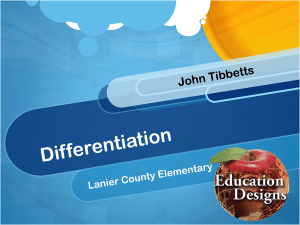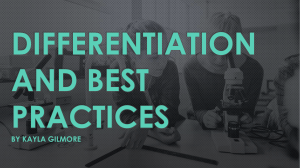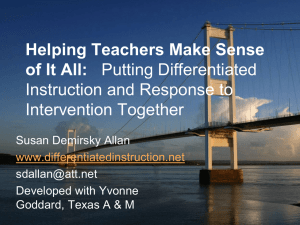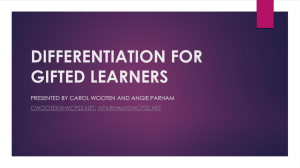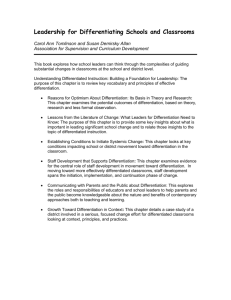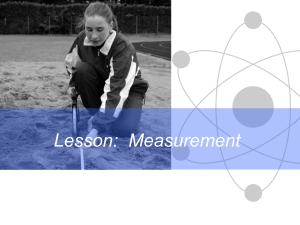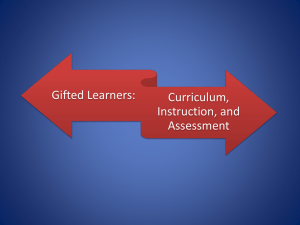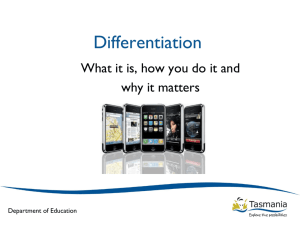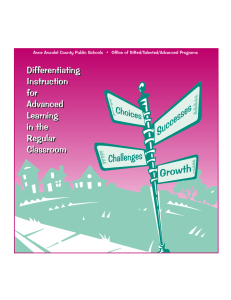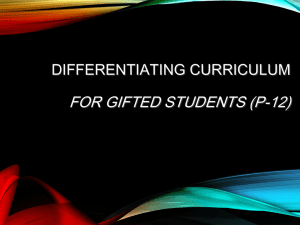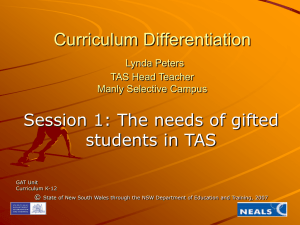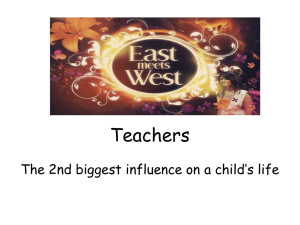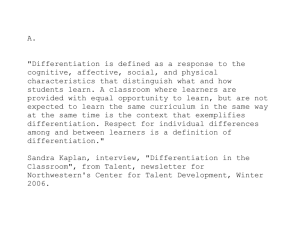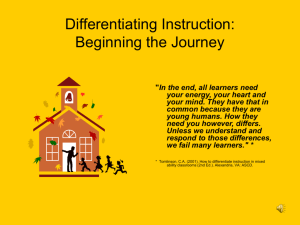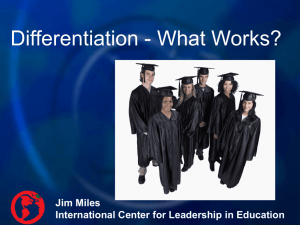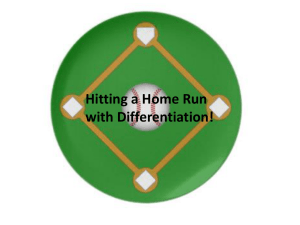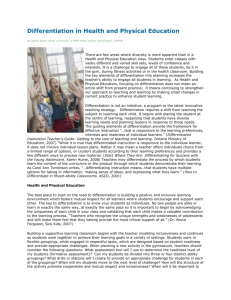Journal 4
advertisement
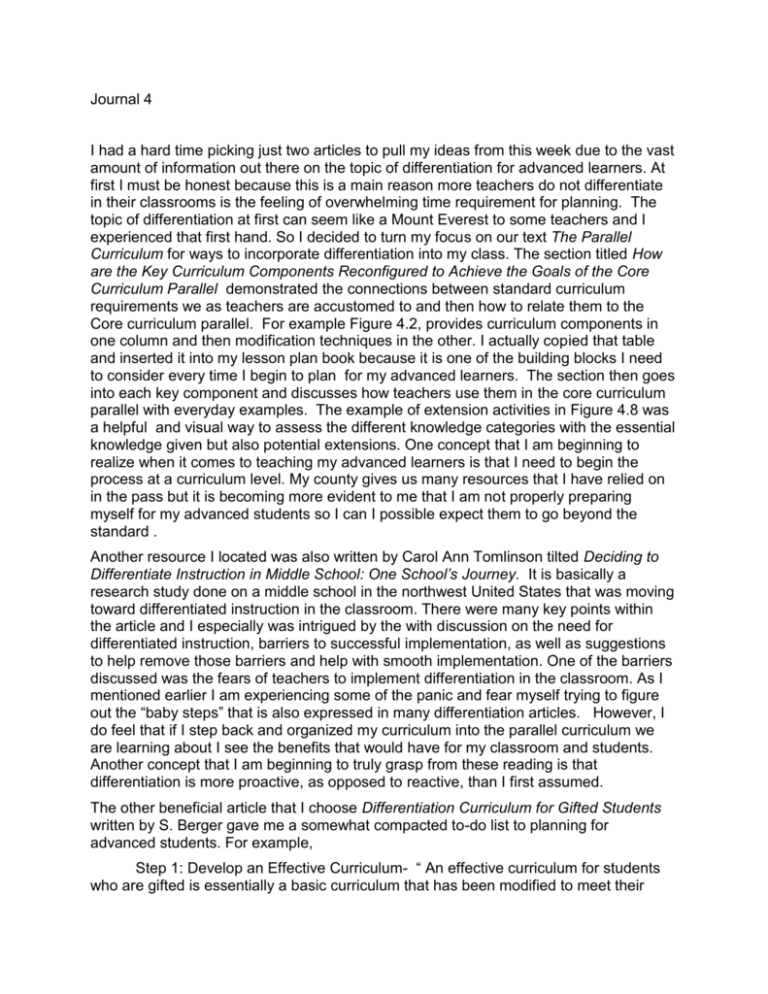
Journal 4 I had a hard time picking just two articles to pull my ideas from this week due to the vast amount of information out there on the topic of differentiation for advanced learners. At first I must be honest because this is a main reason more teachers do not differentiate in their classrooms is the feeling of overwhelming time requirement for planning. The topic of differentiation at first can seem like a Mount Everest to some teachers and I experienced that first hand. So I decided to turn my focus on our text The Parallel Curriculum for ways to incorporate differentiation into my class. The section titled How are the Key Curriculum Components Reconfigured to Achieve the Goals of the Core Curriculum Parallel demonstrated the connections between standard curriculum requirements we as teachers are accustomed to and then how to relate them to the Core curriculum parallel. For example Figure 4.2, provides curriculum components in one column and then modification techniques in the other. I actually copied that table and inserted it into my lesson plan book because it is one of the building blocks I need to consider every time I begin to plan for my advanced learners. The section then goes into each key component and discusses how teachers use them in the core curriculum parallel with everyday examples. The example of extension activities in Figure 4.8 was a helpful and visual way to assess the different knowledge categories with the essential knowledge given but also potential extensions. One concept that I am beginning to realize when it comes to teaching my advanced learners is that I need to begin the process at a curriculum level. My county gives us many resources that I have relied on in the pass but it is becoming more evident to me that I am not properly preparing myself for my advanced students so I can I possible expect them to go beyond the standard . Another resource I located was also written by Carol Ann Tomlinson tilted Deciding to Differentiate Instruction in Middle School: One School’s Journey. It is basically a research study done on a middle school in the northwest United States that was moving toward differentiated instruction in the classroom. There were many key points within the article and I especially was intrigued by the with discussion on the need for differentiated instruction, barriers to successful implementation, as well as suggestions to help remove those barriers and help with smooth implementation. One of the barriers discussed was the fears of teachers to implement differentiation in the classroom. As I mentioned earlier I am experiencing some of the panic and fear myself trying to figure out the “baby steps” that is also expressed in many differentiation articles. However, I do feel that if I step back and organized my curriculum into the parallel curriculum we are learning about I see the benefits that would have for my classroom and students. Another concept that I am beginning to truly grasp from these reading is that differentiation is more proactive, as opposed to reactive, than I first assumed. The other beneficial article that I choose Differentiation Curriculum for Gifted Students written by S. Berger gave me a somewhat compacted to-do list to planning for advanced students. For example, Step 1: Develop an Effective Curriculum- “ An effective curriculum for students who are gifted is essentially a basic curriculum that has been modified to meet their needs. A program that builds on these characteristics may be viewed as qualitatively (rather than quantitatively) different from the basic curriculum; it results from appropriate modification of content, process, environment, and product (Maker, 1982). Step 2: Modifying Content- through acceleration, compacting, variety, reorganization, flexible pacing, the use of more advanced or complex concepts, abstractions and materials. Step 3- Modifying Process- restructure activities to be more intellectually demanding and challenging. Step 4-Modifying Environment- create an environment that is receptive, nonjudgmental, student-centered that encourages inquiry. Step 5- Modifying Product Expectation and Student Response- creating alternative assessments that address real situations, problems, concerns, and audiences. In conclusion, when considering how to teach my advanced learners it is vital to visit the curriculum model and assure that within the curriculum it is concept focused, principle driven, has ongoing and alternative assessments, flexible grouping, and that makes students active in their learning process. I found this visual aid in the article Differentiation for Gifted and Talented Students: Principles and Practices written by Dr Tracy Riley. It sums up the guiding principles we must take into consideration when differentiating for our gifted and advanced students.
